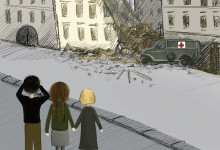
Memories of the Siege: “Before the war I collected sweet wrappers, during the war – fragments of bombs and shells...”
In an effort to preserve the historical memory of the siege of Leningrad the Presidential Library is running a campaign in collaboration with Peterburgsky Dnevnik newspaper and Radio Rossii St. Petersburg. As part of the campaign, Marina Goloushina, St. Petersburg resident, has brought a unique book entitled My Siege, which will be digitized. It was prepared entirely through the efforts of her family and has only two copies in print. The publication features memories of Marina Goloushina’s mother - Zinaida Fedyushina, who spent 872 days of the siege in the city on the Neva, and later described her impressions of the sorrows and little joys of the childhood in the besieged city. Yulya Goloushina, Zinaida Fedyushina’s granddaughter, did illustrations for the book.
Zinaida Fedyushina was a schoolgirl when the Great Patriotic War broke out. That is why she has vivid memories of the summer of 1941 and the siege, which followed.
“I spent the summer of 1941 in a country house (dacha) in Duderhof, 40 km away from Leningrad. I was nine. Uncle and mother, who came from the city, said that the war with the Germans had begun”, the book My Siege reads in part.
The next day, all dacha dwellers tried to go back home. But trains were overcrowded. Zina’s family had great difficulty in finding a car to return to Leningrad.
“Soon my dad was sent to the front. Before leaving, he begged my mother to send me to Romny in Ukraine, where my grandparents lived. He believed that I would be safe there. But the town was occupied, my grandfather and grandmother were burnt by the Germans in their own house ... ”, Zinaida Fedyushina goes on with her story.
In early July 1941, the evacuation of children from Leningrad began. In a freight car children travelled to Pestovo, Novgorod Region. Then on carts they were taken to a village and housed in izbas - log houses. However, this evacuation turned out to be a failure.
“In late July, we felt the anxiety of our teachers: the Germans bombed the train with children, which followed ours, almost all the children died. The Germans were approaching Leningrad. In early August we were sent back to Leningrad”, our heroine recalls.
At the end of the summer, Zinaida’s mother, who was a medical assistant, received a draft card. Grandmother persuaded her to take little Zina to the enlistment office hoping that a woman with a child would not got drafted into the army. But the hall of the enlistment office was crowded with children. Probably everyone decided to do the same ... My mother was drafted into the army, and grandmother became Zina’s guardian. The woman didn’t want to be evacuated and said she would not go anywhere with a child, recalling the unsuccessful evacuation to Novgorod Region.
Zinaida Fedyushina’s memories of the beginning of the siege are associated with bombing. “On September 8, 1941, as usual, we gathered in the yard and saw a crimson red glow in the sky. It was an amazing sight. I still remember that sky. It seemed to have taken up the sky from the Moskovsky Railway Station to the Admiralty. Later we learnt that it was a glow of the fire – the Germans bombed the Badayev warehouses, which were used to store food reserves for the residents of the city”, the pensioner recalls today.
“There was no light at all. Kerosene was poured into a small bottle with a wick to provide light. When it was necessary to light up the kitchen, my grandmother took it, and then I sat in a dark room waiting for light”, the book of the siege survivor reads in part.
Ration cards were distributed in the winter of 1941. At first, ‘butter’ cards were exchanged for powdered eggs and ‘sugar’ cards for cocoa powder. Zinaida’s uncle worked at Monumentskulptura factory. Occasionally he brought carpenter’s glue, which looked like a bar of chocolate. Grandmother crushed it with a hammer, poured water and cooked jelly ... Sometimes uncle brought a bottle of drying oil. Grandmother used it for frying and said that if they didn’t die of starvation or bombing, they would be poisoned by an unpleasant smell.
In the winter of 1942, the yard-keeper told us – primary school-age children - to go down to the bomb shelter, where a teacher gave lessons. “We went there every day and “studied” for several hours. One day we had to wait long for our teacher, but he did not come. A few days later someone told us that he was dead. Our studies finished”, Zinaida Fedyushina recalls.
The pensioner’s main memorabilia of the siege are bomb fragments. “Before the war, I collected sweet wrappers. And during the war - fragments of bombs and shells … Many years later, my son played with these fragments, I gave many away. Now, I carefully keep the remaining ones along with "Resident of Besieged Leningrad" badge ... "
In all, more than 250 people have responded to the call to share memories of the siege within the project launched by the Presidential Library, Peterburgsky Dnevnik newspaper and Radio Rossii St. Petersburg. They have provided about 3,000 documents for digitization.





